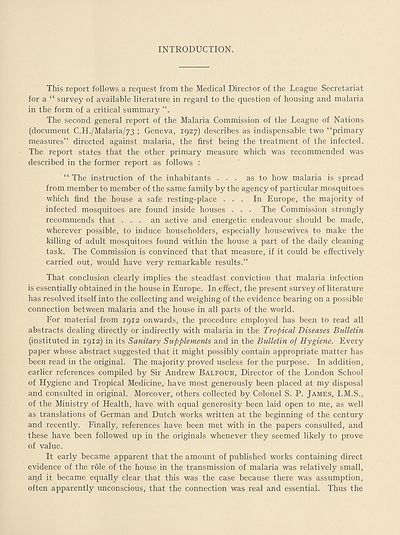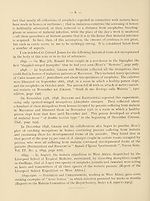Health > Housing and malaria
(7)
Download files
Complete book:
Individual page:
Thumbnail gallery: Grid view | List view

INTRODUCTION.
This report follows a request from the Medical Director of the League Secretariat
for a “ survey of available literature in regard to the question of housing and malaria
in the form of a critical summary
The second general report of the Malaria Commission of the League of Nations
(document C.H./Malaria/73 ; Geneva, 1927) describes as indispensable two “primary
measures” directed against malaria, the first being the treatment of the infected.
The report states that the other primary measure which was recommended was
described in the former report as follows :
“ The instruction of the inhabitants ... as to how malaria is spread
from member to member of the same family by the agency of particular mosquitoes
which find the house a safe resting-place ... In Europe, the majority of
infected mosquitoes are found inside houses . . . The Commission strongly
recommends that ... an active and energetic endeavour should be made,
wherever possible, to induce householders, especially housewives to make the
killing of adult mosquitoes found within the house a part of the daily cleaning
task. The Commission is convinced that that measure, if it could be effectively
carried out, would have very remarkable results.”
That conclusion clearly implies the steadfast conviction that malaria infection
is essentially obtained in the house in Europe. In effect, the present survey of literature
has resolved itself into the collecting and weighing of the evidence bearing on a possible
connection between malaria and the house in all parts of the world.
For material from 1912 onwards, the procedure employed has been to read all
abstracts dealing directly or indirectly with malaria in the Tropical Diseases Bulletin
(instituted in 1912) in its Sanitary Supplements and in the Bulletin of Hygiene. Every
paper whose abstract suggested that it might possibly contain appropriate matter has
been read in the original. The majority proved useless for the purpose. In addition,
earlier references compiled by Sir Andrew Balfour, Director of the London School
of Hygiene and Tropical Medicine, have most generously been placed at my disposal
and consulted in original. Moreover, others collected by Colonel S. P. James, I.M.S.,
of the Ministry of Health, have with equal generosity been laid open to me, as well
as translations of German and Dutch works written at the beginning of the century
and recently. Finally, references have been met with in the papers consulted, and
these have been followed up in the originals whenever they seemed likely to prove
of value.
It early became apparent that the amount of published works containing direct
evidence of the role of the house in the transmission of malaria was relatively small,
and it became equally clear that this was the case because there was assumption,
often apparently unconscious, that the connection was real and essential. Thus the
This report follows a request from the Medical Director of the League Secretariat
for a “ survey of available literature in regard to the question of housing and malaria
in the form of a critical summary
The second general report of the Malaria Commission of the League of Nations
(document C.H./Malaria/73 ; Geneva, 1927) describes as indispensable two “primary
measures” directed against malaria, the first being the treatment of the infected.
The report states that the other primary measure which was recommended was
described in the former report as follows :
“ The instruction of the inhabitants ... as to how malaria is spread
from member to member of the same family by the agency of particular mosquitoes
which find the house a safe resting-place ... In Europe, the majority of
infected mosquitoes are found inside houses . . . The Commission strongly
recommends that ... an active and energetic endeavour should be made,
wherever possible, to induce householders, especially housewives to make the
killing of adult mosquitoes found within the house a part of the daily cleaning
task. The Commission is convinced that that measure, if it could be effectively
carried out, would have very remarkable results.”
That conclusion clearly implies the steadfast conviction that malaria infection
is essentially obtained in the house in Europe. In effect, the present survey of literature
has resolved itself into the collecting and weighing of the evidence bearing on a possible
connection between malaria and the house in all parts of the world.
For material from 1912 onwards, the procedure employed has been to read all
abstracts dealing directly or indirectly with malaria in the Tropical Diseases Bulletin
(instituted in 1912) in its Sanitary Supplements and in the Bulletin of Hygiene. Every
paper whose abstract suggested that it might possibly contain appropriate matter has
been read in the original. The majority proved useless for the purpose. In addition,
earlier references compiled by Sir Andrew Balfour, Director of the London School
of Hygiene and Tropical Medicine, have most generously been placed at my disposal
and consulted in original. Moreover, others collected by Colonel S. P. James, I.M.S.,
of the Ministry of Health, have with equal generosity been laid open to me, as well
as translations of German and Dutch works written at the beginning of the century
and recently. Finally, references have been met with in the papers consulted, and
these have been followed up in the originals whenever they seemed likely to prove
of value.
It early became apparent that the amount of published works containing direct
evidence of the role of the house in the transmission of malaria was relatively small,
and it became equally clear that this was the case because there was assumption,
often apparently unconscious, that the connection was real and essential. Thus the
Set display mode to:
![]() Universal Viewer |
Universal Viewer | ![]() Mirador |
Large image | Transcription
Mirador |
Large image | Transcription
Images and transcriptions on this page, including medium image downloads, may be used under the Creative Commons Attribution 4.0 International Licence unless otherwise stated. ![]()
| League of Nations > Health > Housing and malaria > (7) |
|---|
| Permanent URL | https://digital.nls.uk/191817589 |
|---|
| Shelfmark | LN.III |
|---|---|
| Description | Over 1,200 documents from the non-political organs of the League of Nations that dealt with health, disarmament, economic and financial matters for the duration of the League (1919-1945). Also online are statistical bulletins, essential facts, and an overview of the League by the first Secretary General, Sir Eric Drummond. These items are part of the Official Publications collection at the National Library of Scotland. |
|---|---|
| Additional NLS resources: |
|

